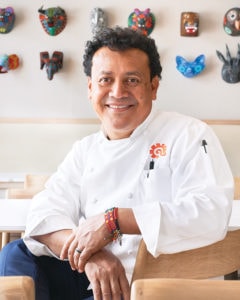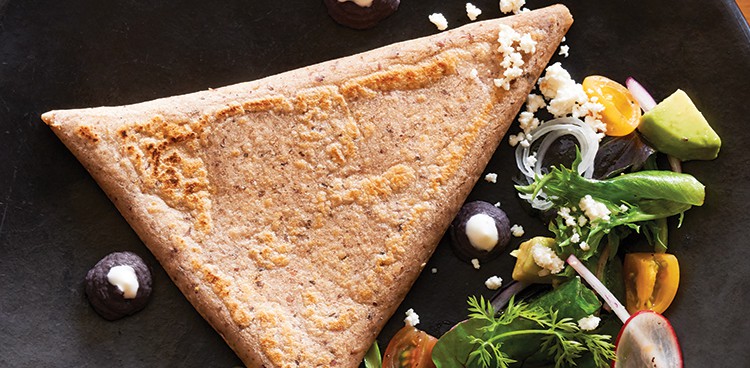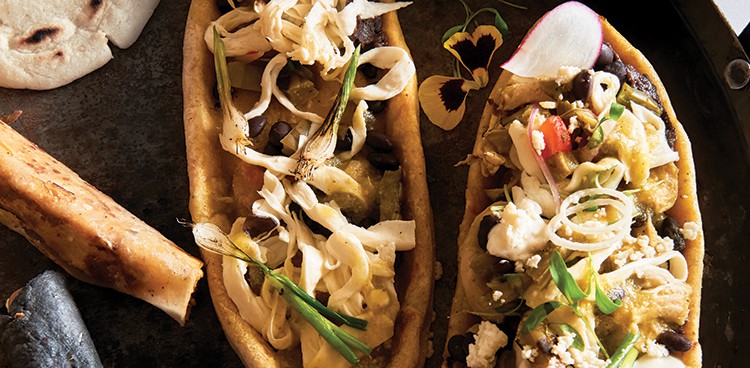
Houston chef Hugo Ortega didn’t truly appreciate his native culture until he left it. When he decamped from Mexico in 1984, Ortega didn’t set out to work in restaurant kitchens. The then-17-year-old hopped a bus from Mexico City to Ciudad Juárez with a simple goal: to support himself and the large family he left behind. He headed east to Houston, where a relative had settled already. Ortega started cleaning offices and lived with an older cousin who traveled with him from Mexico. The cleaning company and cousin both relocated, though, leaving him homeless and looking for work. Fellow immigrants with whom he played pick-up soccer helped him land a job bussing tables and washing dishes at Houston’s Backstreet Café, a New American bistro opened by restaurateur Tracy Vaught in 1983.

Chef Hugo Ortega
Today the restaurant is thriving; Ortega has been executive chef for the last 12 years. He owns it with Vaught, who long ago hired and promoted the young immigrant through the kitchen ranks. Married since 1994, the pair has one daughter, five restaurants, and several James Beard Award nominations—and one win—between them. (Vaught has been up for Outstanding Restaurateur twice; Ortega, after six nominations, was named Best Chef: Southwest this spring.)
Cooking helped Ortega explore his native country in new ways, he says. “I began to see the incredible heritage that I have coming from a place like Mexico—the richness of the culture and the music and the food and the people.” He graduated from the Culinary Arts program at Houston Community College in 1992, but the traditional Pueblan recipes and techniques he learned from his mother and grandmother remain the foundation of his craft.
Backstreet Café was Ortega’s entrée to the restaurant world, but the chef has gone on to launch more diverse eateries that emphasize his background. Hugo’s—which Ortega and Vaught opened in 2002—is his paean to regional Mexican cuisine. Sunday brunch at the acclaimed eatery is stacked with chicken-and-tomatillo chilaquiles oozing with over-easy eggs; chiles rellenos; and a glut of tamale varieties, a must among local foodies. Caracol, Ortega’s showcase for coastal Mexican cuisine, followed in 2013.
Earlier this year, the couple’s H Town Restaurant Group debuted Xochi, Houston’s first upscale Oaxacan restaurant. “In many ways, Oaxaca is the belly of the country,” says Ortega. The region’s indigenous foodways—dating back to pre-Colombian times—are revered both in Mexico and around the world, he explains.
Texan diners are surrounded by Mexican food, of course, from gas station breakfast tacos to fancy ceviche. Dishes served at Xochi, however, take a deeper cultural dive, unfamiliar to many. First, there are insects. Chapulines, or grasshoppers, crown several dishes; they join maguey worms and flying ants in a dish with housemade cotija and pork rinds.

Queso del Rancho, a signature dish at Xochi, is topped with grasshoppers, maguey worms, and flying ants
Beyond bugs, sauces such as mole almendrado and its sweet, subtle combination of almonds, tomatoes, and olives, are revelations. Masa dumplings and wild mushrooms in mole amarillo—a sauce less complex than the chocolaty mole poblanos most Americans know—offer delicious education, too. Xochi is also a playground for Ortega’s brother, Ruben, the restaurant group’s executive pastry chef. His edible objets d’art include a play on corn that features ear-shaped corn ice cream, queso fresco ice cream, a corn cookie, and blue-corn cream. An entire section devoted to chocolate treats includes the Instagram-worthy Cacao, a realistic cacao pod made from painted white chocolate brimming with cocoa desserts like cake, ice cream, and “criollo soil” (coarse chocolate-sugar crumbs).

Ortega and Vaught’s newest restaurant, Xochi, focuses on the flavors of Oaxaca
Xochi was partly inspired by time Ortega and Vaught spent in Oaxaca. Last year they added Oaxaca City restaurant Origen— co-owned by Rodolfo Castellanos, the first “Top Chef Mexico” winner—to H Town’s culinary pantheon. Touring the remote region, where locally available ingredients dictate diet, plunged Ortega back into a world of rustic seasonality that he hadn’t experienced since cooking with his grandmother, Delia. He recalls waiting impatiently for summer to come every year so he and his family could eat watermelon, tomatoes, and cucumbers.
In subtropical Houston, seasons are less distinct—this is an area where citrus and strawberries thrive in winter. Still, Ortega works with farmers to source delicacies that are ephemeral even in the Lone Star State. Squash blossoms, for example, are only available in spring and they pop up on Hugo’s menu in May and June, courtesy of farmer Pat Rapesak of Fresh Herbs of Houston, in Needville, Texas. During that short time, squash blossoms appear in cocktails and quesadillas, and are also stuffed with chèvre.
Cheese is central to Ortega’s cuisine—from a funky blue on grilled pear flatbread at Backstreet Café and shrimp filled with poblano peppers and Chihuahua cheese at Caracol to corn soup at Xochi that incorporates earthy huitlacoche (corn fungus) and queso fresco. In fact, Ortega has such respect for dairy that his kitchens produce much of the cheese he uses.
“We’ve been making quesillo for many years at Hugo’s and also at Caracol,” he says. The Oaxacan string cheese tastes like tangier mozzarella, and though it’s easy to locate in heavily Mexican Houston (at last count, 37 percent of the city’s population identifies as Hispanic or Latino—many among them from Mexico), Ortega thinks that his team can make it better.
It’s that kind of confidence and work ethic that propelled Ortega from undocumented immigrant to naturalized citizen and executive chef of a growing restaurant group in the span of a decade. Ortega visits Mexico frequently, not only to check on Origen and see family but also for inspiration—proof that opportunity flows both ways at the border.
Five Recipes by Chef Hugo Ortega
Elotes Asados
Freshly ground chiles and the sweetest summer corn elevate this iconic Mexican street food.
Telelas
Named for a small town in Oaxaca, tetelas are a triangular, indigenous equivalent to the quesadilla, but made with fresh masa.
Queso Flameado
Hot, melted cheese in a skillet? Party time!
Enchiladas de Pollo y Queso (Chicken-and-Cheese Enchiladas)
Semi-soft Chihuahua cheese is also known as menonita in Mexico, as it was produced in its namesake state by members of the Mennonite community.
Huaraches con Nopales y Frijoles de Olla (Sandal-Shaped Masa Cakes with Dried Cactus Paddles and Beans)
Huaraches—which translates to “sandals”—are oblong masa cakes that serve as a savory platform for beans and cactus in this dish from Hugo Ortega’s childhood.







